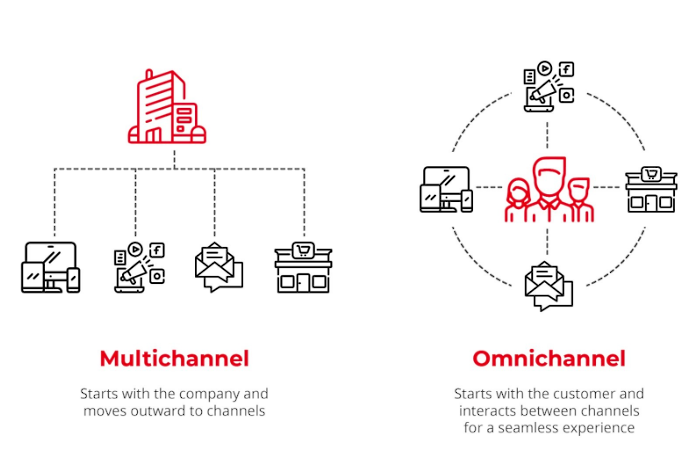
Omnichannel e-commerce provides the opportunity for every brand to create a cohesive purchasing experience throughout multiple potential shopping channels. Because while 63% of all shopping journeys begin online, 60% of shoppers prefer in-store shopping for a variety of reasons, almost a third of Americans have purchased items directly from social media, and ecommerce app revenue grew by over 20% in 2021.
This makes implementing a seamless omnichannel ecommerce experience increasingly important. Businesses can integrate every channel from social media to physical and digital storefronts, creating a comprehensive shopping experience for customers wherever they interact with your brand.
This article will review what omnichannel ecommerce is, its advantages and limitations, and how to building an omnichannel ecommerce strategy for your business.
Table of Contents
What’s the Difference Between Omnichannel and Multichannel Retailing?

Omnichannel eCommerce
With Omnichannel eCommerce, a business has multiple channels that all work together synergistically. A customer can start on one channel and flow seamlessly to another, with everything easily connected so the shopping experience is cohesive and convenient.
For example, if someone discovers the business’s social media page they can start shopping right there and if they decide to go to the company website, their cart will transfer over as well. Another example would be how the inventory in a physical store is reflected online, so if a particular item sells out in-store it will immediately be reflected in the online store.
Some of the main channels to reach customers include:
- eCommerce marketplaces
- Mobile websites and applications
- Social media platforms
- Online live chat
- SMS messaging
- Customized email marketing
- Web stores
Multichannel eCommerce
With Multichannel eCommerce, a business has multiple channels that are separate from each other. While they might have the same channels available that an omnichannel business has, with multichannel eCommerce, they are not linked together for a seamless shopping experience.
Advantages & Challenges of Omnichannel eCommerce
Here are some of the advantages and disadvantages of omnichannel ecommerce to give you a better picture of what you can get out of it.
Advantages
- Greater Customer Reach: Using an omnichannel ecommerce strategy allows you to reach your customers wherever they are. Regardless of what platform they are on, customers have the ability to find everything they need to connect with you or make a purchase right there.
- Increased Sales: If you are selling products or services, having them available for purchase on multiple channels will make it easier for potential customers. The easier you make it for them, the more likely they are to do business with you. An omnichannel retail experience also makes it easier for previous customers to purchase from you again or renew subscriptions.
- Increased Customer Satisfaction & Engagement: Keeping customers happy is the main objective in order to build a thriving business. When customers know they can reach you on any channel or device whether a customer is looking to make a purchase or talk to customer service, they will be grateful that they can reach you on their preferred device and channel.
Challenges
- Brick-and-Mortar Store Stock vs Online Stock: Displaying the in-store stock of items online can be a great way to keep people up to date on which products are available. This can be an issue at times when items sell out both online and in-store prior to being updated. For this reason, it can help to limit the online availability of some items that sell better in-store.
- Lack of Infrastructure: An omnichannel strategy can be complex for a business that isn’t used to this approach, since they need to maintain and be responsive on each channel simultaneously. Omnichannel ecommerce requires some extra diligence when getting started.
- Working With the Right Partners: The partners that you work with will have to be able to handle the increased demand that comes with implementing an omnichannel strategy. Communication with your partners is important to make sure they are up to the task.
How to Build an Omnichannel eCommerce Strategy

1. Outline the Customer Journey
The first step in developing an omnichannel strategy is to understand how customers will find you, learn about you, and ultimately purchase a product or service from you. This customer journey can look different from person to person but it will help to map out common paths your target market will take.
Put yourself in the customers’ shoes, how are they finding you and why are they continuing to look at your content? What are their pain points, interests, or common past purchases?
Defining the purchasing funnel will help you outline the customer journey from awareness to purchase. Many businesses hire marketing agencies to help with this step.
2. Create Engaging Content for Each Platform
Now that you have a solid understanding of the path that your customers may take, it’s time to start creating content for each channel to pull them in and nurture them through the funnel.
Every platform has its own specific target audience so your content must cater to each platform uniquely. Your message will be the same, you want to have a consistent brand voice, however, you want to understand how to deliver it in the right way for each platform.
For example, when posting on Instagram, you want to take some captivating photos that will really grab your audience. When you post on TikTok, create short videos that engage the audience either with comedy or some mind-blowing information. The more platforms you can target the wider range of audiences you will reach.
Sellest.ai offers optimized Amazon product listings which is one of the best ways to ensure you effectively engage customers shopping on Amazon. No matter how incredible website and social media pages are, shoppers might resort to making purchases on Amazon because of its convenience and reliability. You’ll want to offer the best possible product listings to engage your customers and increase conversions.
3. Implement Customer Service Tools
There are many customer service tools available to improve the customer experience at any point in the journey. Doing your homework and knowing who your customers are is the easiest way to tailor customer service to them. However, if you are still determining what the best option for your business is, the best move is to offer customer engagement options where they can provide feedback.
Providing direct contact via phone or email is a good way to connect with customers. There are also automated options such as chatbots that can provide access to quick assistance. You can also offer live chat or live video options at certain times of the day if you have more limited time and resources.
4. Define Channel Goals
Every channel offers a different audience that reacts to different types of content. There is no such thing as a one-size-fits-all approach that will be a hit on every platform. It would be doing your business a disservice to create one piece of content and then blast it across all channels without changing anything.
With that said, the next step is understanding which platforms are best for directly promoting your products and which ones are best to just engage potential customers. You don’t want to waste time implementing selling strategies on a channel that no one is going to be buying on.
Identifying your target audience and how they interact with each channel will allow you to tailor your content to the specific ways customers are likely to interact with each channel.
5. Ensure Your Website Is Optimized for Mobile
Having a website that is optimized for mobile is essential. Not everyone has access to a computer all day long, but the majority of the global population has a smartphone on them throughout the day. In fact, according to Oberlo.com 6.8 billion people worldwide own a smartphone. With a global population of 8 billion people, that means 80% of the population has a smartphone on them throughout the day. For that reason alone, you could lose a ton of business by not giving customers access to a mobile-optimized website on their devices.
The mobile site should be easy to navigate and allow customers to shop and check out when they are ready. It may be an added cost to have a mobile site developed but it will pay off in the long run.
6. Be Responsive on All Channels
Being available and quickly responding to your customers is one of the keys to customer loyalty.
With so many different ways for people to reach out to your business, it’s important to stay on top of every one of them. That means fielding questions via email while responding to comments on Instagram and direct messages on LinkedIn.
All of this needs to be done while maintaining a seamless customer experience on your website. It can seem overwhelming but as long as your team stays on top of everything and addresses questions quickly, you can build trust with your customers and keep them happy.
7. Implement Data Analytics & Testing
In order to implement data analytics for your omnichannel ecommerce business, everything must be synced across all channels. This will give you the clearest picture of your customer journey and allow you to accurately track channel performance and make informed decisions on where to make improvements.
The best businesses are continuously testing and implementing new strategies for funnel optimization. What worked last year might not work this year, so it’s important to stay on top of who your ideal customers are and what they want. You want to be able to listen to their feedback and implement changes as needed.
Enhance Your Omnichannel eCommerce Strategy With Optimized Amazon Product Listings
Omnichannel ecommerce is an intensive sales strategy that puts the customer at the forefront. With cohesive and integrated channels, businesses can effectively nurture customers no matter what channels they’re on and provide a delightful shopping experience from start to finish.
Amazon is one of the most widely used ecommerce platforms in the world and is a common pillar for most omnichannel businesses. Having optimized Amazon product listings allows you to attract the right customers and increase conversions.
Sellesta makes it easy to optimize your Amazon product listings by offering AI-powered tools for keyword research, customer review analysis, and more.


